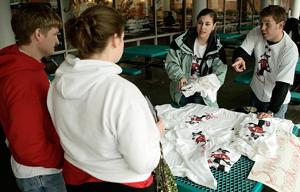
William Alligood
To raise money for an upcoming academic competition, students in an advertising class used copyrighted and trademarked images without administrative permission, according to Cindy Sears, director of Trademark Licensing.
“We proposed as a fundraiser that we’d do T-shirts,” Claudia Kimbrough, a lecturer in business management, said. “I didn’t have any idea there were going to be issues.”
The T-shirt, which was being sold to fund entry into the National Student Advertising Competition, displayed a cartoon wolf, formally printed in Technician several years ago on the front, along with a different cartoon wolf on the back, which the University said was used without their consent.
“It’s a tracing of a fairly older illustration,” Mark McLawhorn, an interface designer for Information Technology and Technician cartoonist, said. “People are going to associate this stuff with me.”
Ryan Rieth, a senior in business management and communication, said he didn’t realize the material was copyrighted when he obtained the design from a photo gallery at TheWolfWeb.com.
“I didn’t copy it exactly,” he said. “The picture isn’t the same.”
McLawhorn said the way the material was gathered is not a defense.
“Just because it’s on the Internet doesn’t mean it’s free,” he said.
Rieth said he changed the images of the wolf’s hat and foot on the front of the shirt and “thought it was fine.”
According to Sears, the students would not have had a problem obtaining permission to use the material.
“As long as the design is approved through our office, the printer has permission to use the design,” Sears said, noting the availability of request forms on the department’s Web site.
Though the University could press charges against the group, Sears said “it’s a possibility that the shirts would be confiscated,” and it is doubtful to raise legal action between the parties involved.
“If we find them and they still have shirts, we [will] prevent the sale of any further shirts,” she said.
Bradley Wilson, coordinator of the Student Media Authority, said he views the acts of the students similar to that of plagiarism, and said giving someone credit for his or her work “[is] not a difficult concept.”
Wilson, a former advisor of McLawhorn’s, said he is “not inclined to pursue anything.”
“The professor needs to impress upon the students the importance of the copyright laws of the United States,” he said, adding this situation reminds him of an incident last year when the Wolfpack Student Initiative had T-shirts, which were being sold to raise scholarship money, confiscated by law enforcement officials for using University images without permission.
Kimbrough said she did not see the final design of the T-shirt and was unaware the original artwork was going to be on the shirts.
“[Rieth] told us he was going to take the basic idea [of the cartoons,]” she said. “He told us the design would be similar to the one he showed us, but that he would use original art.”
Another T-shirt idea, depicting UNC-Chapel Hill basketball coach Roy Williams with a diaper and a rattle, was proposed, but a printing company, separate from the one used for the T-shirts in question, wouldn’t print it and the class decided to terminate the plan for that particular design, according to Kimbrough.
Sears said her “biggest concern is with the printer who printed the shirts. They shouldn’t have printed without our permission unless they are a licensed vendor.”
The T-shirts were printed at a small undisclosed company in Charlotte, according to Rieth, who said he is friends with an employee. Students in the class paid for the initial printing, and, as of yesterday afternoon, hadn’t made their money back.
“I handdrew this myself because I had to do the template,” Rieth said. “I looked at [McLawhorn’s] picture as an idea generator, but I wasn’t trying to copy anybody.”
He said he didn’t realize it was copyrighted because he “figured once you changed somebody’s picture, it isn’t their picture anymore since it isn’t the original artwork.”
McLawhorn said he is upset Rieth failed to ask his permission, because he “would’ve been more than happy to help [his class] out,” adding “it’s too late now.”
“There was no reason why [Rieth] couldn’t have dropped a line and asked to use it,” McLawhorn, who is assisting another class with a similar project, said. “He’s going to an advertising workshop, and the things he’s doing would never fly in the real advertising world.”
Rieth maintained his stance the project was innocent.
“I don’t want anybody to get into any serious trouble over this,” he said. “Nobody was trying to cause any trouble. I didn’t think anybody would get mad about it.”
Kimbrough said this was a learning experience and she will convey responsible advertising practices to her students.
“We all have to learn to be much more careful about regulations and legal implications of the actions that we take,” she said. “More care needs to be given into what we’re doing. I need to be just as careful as they do.”